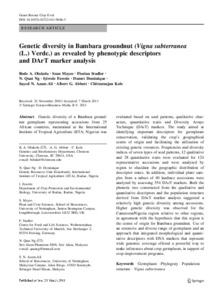| dc.contributor.author | Olukolu, B.A. |
| dc.contributor.author | Mayes, S. |
| dc.contributor.author | Stadler, F. |
| dc.contributor.author | Ng, N.Q. |
| dc.contributor.author | Fawole, I. |
| dc.contributor.author | Dominique, D. |
| dc.contributor.author | Azam-Ali, S.N. |
| dc.contributor.author | Abbott, A.G. |
| dc.contributor.author | Kole, C. |
| dc.date.accessioned | 2019-12-04T11:10:35Z |
| dc.date.available | 2019-12-04T11:10:35Z |
| dc.date.issued | 2011-03 |
| dc.identifier.citation | Olukolu, B.A., Mayes, S., Stadler, F., Ng, N.Q., Fawole, I., Dominique, D., ... & Kole, C. (2012). Genetic diversity in Bambara groundnut (Vigna subterranea (L.) Verdc.) as revealed by phenotypic descriptors and DArT marker analysis. Genetic Resources and Crop Evolution, 59(3), 347-358. |
| dc.identifier.issn | 0925-9864 |
| dc.identifier.uri | https://hdl.handle.net/20.500.12478/2201 |
| dc.description.abstract | Genetic diversity of a Bambara groundnut germplasm representing accessions from 25 African countries, maintained at the International Institute of Tropical Agriculture (IITA; Nigeria) was evaluated based on seed patterns, qualitative characters, quantitative traits and Diversity Arrays Technique (DArT) markers. The study aimed at identifying important descriptors for germplasm conservation, validating the crop’s geographical centre of origin and facilitating the utilization of existing genetic resources. Frequencies and diversity indices of seven types of seed patterns, 12 qualitative and 28 quantitative traits were evaluated for 124 representative accessions and were analyzed by region to elucidate the geographic distribution of descriptor states. In addition, individual plant samples from a subset of 40 landrace accessions were analyzed by assessing 554 DArT markers. Both the phenetic tree constructed from the qualitative and quantitative descriptors and the population structure derived from DArT marker analysis suggested a relatively high genetic diversity among accessions. Higher genetic diversity was observed for the Cameroon/Nigeria region relative to other regions, in agreement with the hypothesis that this region is the centre of origin for Bambara groundnut. Use of an extensive and diverse range of germplasm and an approach that integrated morphological and quantitative descriptors with DNA markers that represent wide genomic coverage offered a powerful way to make inferences about crop germplasm, in support of crop-improvement programs. |
| dc.language.iso | en |
| dc.subject | Germplasm |
| dc.subject | Phylogeny |
| dc.subject | Population Structure |
| dc.subject | Vigna Subterranea |
| dc.title | Genetic diversity in bambara groundnut (Vigna subterranea (L.) verdc.) as revealed by phenotypic descriptors and DArT marker analysis |
| dc.type | Journal Article |
| dc.description.version | Peer Review |
| cg.contributor.affiliation | Clemson University |
| cg.contributor.affiliation | International Institute of Tropical Agriculture |
| cg.contributor.affiliation | University of Ibadan |
| cg.contributor.affiliation | University of Nottingham |
| cg.contributor.affiliation | Technische Universität München |
| cg.contributor.affiliation | Seri Alam Plantation SDN, Malaysia |
| cg.coverage.region | Africa |
| cg.coverage.region | West Africa |
| cg.coverage.region | Central Africa |
| cg.coverage.country | Nigeria |
| cg.coverage.country | Cameroon |
| cg.isijournal | ISI Journal |
| cg.authorship.types | CGIAR and developing country institute |
| cg.iitasubject | Biodiversity |
| cg.journal | Genetic Resources and Crop Evolution |
| cg.howpublished | Formally Published |
| cg.accessibilitystatus | Limited Access |
| local.dspaceid | 90932 |
| cg.identifier.doi | https://dx.doi.org/10.1007/s10722-011-9686-5 |

